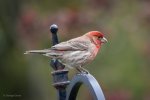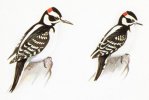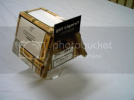This is absolutely true, but in the field, it's often hard to determine the relative size of a bird without seeing a reference bird (or reference suet feeder!). This is especially challenging when looking through binoculars. When I do have to figure out a bird's size to assist me in identification, I always make that determination with the naked eye, as binos can really distort your approximation.
For the Hairy vs. Downy determination, I use the trick of looking at the size of their bill vs. the rest of their head. If you look at the picture below, you can see that a Hairy's bill is nearly as long as the rest of its head, whereas a Downy's bill is only about half the size of its head. I find this to be more reliable than trying to determine a bird's relative size.
View attachment 55205
The Audobon website gives a few other tips for identifying Downy vs Hairy, and offers this bit of guidance:
Lastly, it’s important to note that the Downy Woodpecker is much more abundant than its Hairy counterpart, especially in suburbia. The Hairy prefers towering trees and deeper woods, while the Downy will settle for baby birches and cattails.
When I was a beginning birder, I'd just look at the bird and try to figure out what it was from the physical clues. Now, I use habitat as my first filter of what the bird might be. Knowing that Downies are frequent suburban visitors and Hairies are not generally sets me to cue into the bill to make sure it's not a Hairy.







